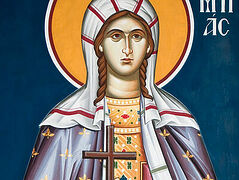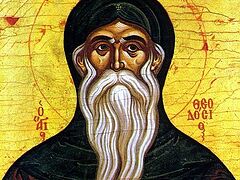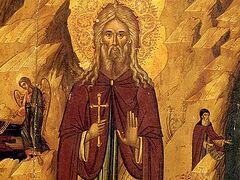The saint was born in Constantinople, into a pious and prominent family. Theophanes’ father was related to the Byzantine Emperor Leo III the Isaurian (717–741). Three years after Theophanes’ birth, his father died, leaving his family to the care of the emperor himself. Theophanes grew up at the palace and became a high official in the court of Emperor Leo IV Khazar (775–780). His position required that he marry. With the consent of his bride, Theophanes lived a life of chastity, for in his soul he had a growing desire to adopt the monastic life. While he and his wife were visiting the monasteries of the Sygriane region of Asia Minor, Theophanes met the clairvoyant Elder Gregory of Stratigios, who foretold Theophanes’ wife that her husband would be made worthy of a martyr’s crown. Sometime later, Theophanes’ wife was tonsured a nun in one of the monasteries of Bithynia, and Theophanes was tonsured a monk by Elder Gregory. With the Elder’s blessing. Theophanes established a monastery on the island of Kalonymos in the Sea of Marmora and locked himself up in a cell, where he copied books. Theophanes achieved great mastery in this craft. Later, the Venerable Theophanes founded and became abbot of another monastery, in the Sygriane region, in a place known as the “Great Village.” The saint personally took part in all the work of the monastery and was a model to all of diligence and spiritual struggle. The Lord made him worthy to receive the gift of working miracles, of healing the sick of diseases, and of exorcising demons. In 787, the seventh Ecumenical Council, which condemned iconoclasm, was held in Nicaea. St. Theophanes was among those summoned to the Council. He arrived in patched and tattered rags, but he shone with Divinely inspired wisdom in affirming the dogmas of True Orthodoxy.
At age 50, the saint fell seriously ill, and suffered greatly until his death. On his deathbed, the venerable one constantly struggled: He wrote the Chronographia. the history of the Christian Church from 285–813. To this day, that work remains a valuable resource with respect to the history of the Church.
With the coronation or Emperor Leo the Armenian (813–820), when the saint was already of quite advanced age, there was a resurgence of iconoclasm. The iconoclasts tried to coerce St. Theophanes into adopting the heresy. He firmly resisted and was cast into prison. His “Great Village” monastery was put to the torch. After twenty-three days of imprisonment, the venerable confessor reposed (†818). After the death of impious Emperor Leo the Armenian, the “Great Village” monastery was reestablished, and the holy relics of the saint were transferred to it.
Parish Life, March 2021.
St. John the Baptist Church, Washington, DC




